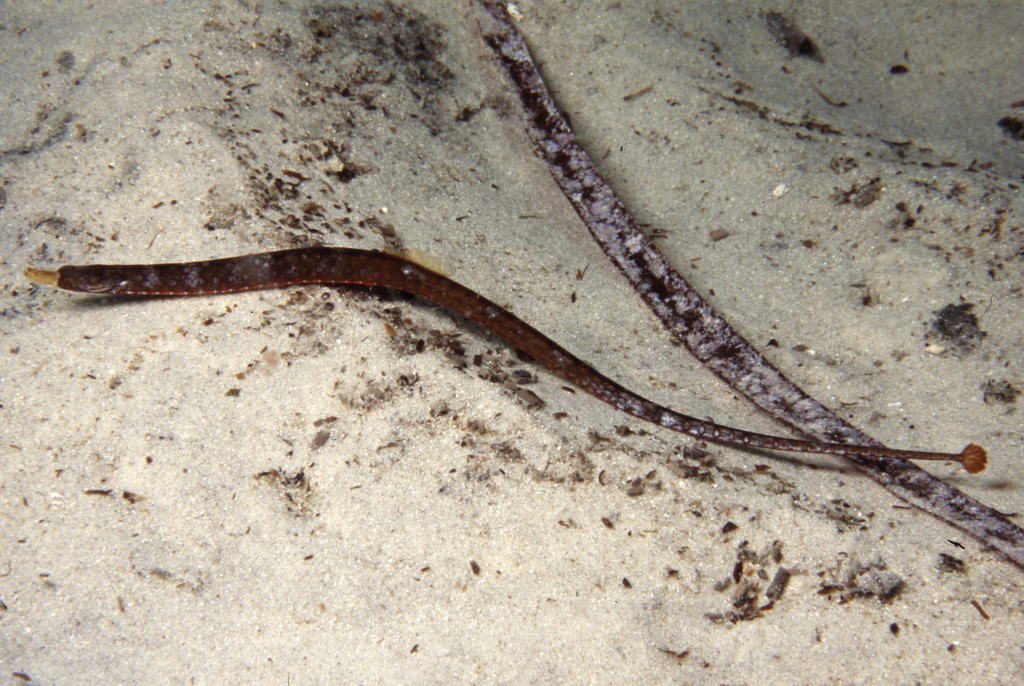- Classification
- ACTINOPTERYGII
- SYNGNATHIFORMES
- SYNGNATHIDAE
- Pugnaso
- curtirostris
Pugnose Pipefish, Pugnaso curtirostris (Castelnau 1872)

A Pugnose Pipefish, Pugnaso curtirostris, at Normanville, South Australia. Source: David Muirhead / MLSSA, mlssa.asn.au. License: CC BY Attribution-Noncommercial-ShareAlike
A brown pipefish often with a pale or variegated mottled pattern, and faint rectangular dark brown blotches usually on the lower half of most trunk rings. Some individuals are plain with 12-14 narrow dark bars dorsally, while others are completely mottled or variegated.
Pugnose Pipefish, Pugnaso curtirostris (Castelnau 1872)
More Info
|
Distribution |
Southern Australia, from Corner Inlet, Wilsons Promontory (Victoria), northern Tasmania and the Bass Strait islands, to Jurien Bay and the Houtman Abrolhos Islands (Western Australia). Uncommon in Gulf St Vincent and Spencer Gulf, South Australia. Inhabits shallow seagrass, eelgrass and algal habitats in sheltered bays and estuaries to a depth of about 11 m. Juveniles often shelter amongst decaying seagrass leaves. |
|
Features |
Dorsal fin 21–25; Pectoral fin 8–11; Anal fin 2–3; Caudal fin 10; trunk rings 17–19; tail rings 41–44; subdorsal rings 1.75–0.25 + 3.25–5.00 = 4.50–5.75. Body elongated, upper surface usually flat to slightly convex, trunk shallow; head aligned with body; snout short, 33–40% HL; snout depth 29–59% snout length; median dorsal snout ridge low, entire; longitudinal opercular ridge vestigial or absent in adults and subadults, usually complete and angled upward towards gill opening in young; principal body ridges often indistinct; superior trunk and tail ridges discontinuous near rear of dorsal-fin base; inferior trunk and tail ridges continuous; lateral trunk ridges not confluent with tail ridges; tail not prehensile. Females slightly deeper-bodied than males. Dorsal fin slightly closer to tip of snout than to tip of tail, base of moderate length; anal fin tiny, below front half of dorsal fin; caudal fin very small. |
|
Size |
To 19 cm SL. |
|
Colour |
Colour variable, mostly pale brown with faint quadrate dark brown blotches on lower half of most trunk rings. Some individuals are plain with 12–14 narrow dark bars dorsally, others are mottled or variegated throughout. |
|
Feeding |
Carnivore - feeds on small crustaceans, including mysid shrimps, sucked off the substrate. |
|
Biology |
Reproductive mode: Males brood eggs in an enclosed pouch on the underside of the tail just behind the anal fin. The pouch has large overlapping skin flaps to protect the developing eggs. By about 14 cm SL, males may be brooding eggs during late spring and summer. Eggs: Not described; males brood between 50 to 90 eggs per brood in two to four rows in pouch. Larvae: Not described. |
|
Conservation |
IUCN Red List Status: Least Concern |
|
Remarks |
|
|
Similar Species |
Pugnaso is most similar to species of the genus Vanacampus, differing in the absence of the opercular ridge in subadults and adults, in the reduced development of other head ridges, in the absence of ridges on the pectoral fin base and in usually having slightly convex dorsal and ventral surfaces of the tail (depressed or concave in Vanacampus). |
|
Etymology |
Pugnaso is from the Latin nasus (nose). The specific name curtirostris is from the Latin curtus (short) and rostrum (snout) in reference to the short snout of this species. |
|
Species Citation |
|
